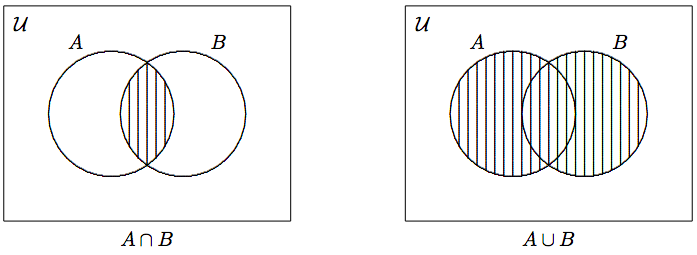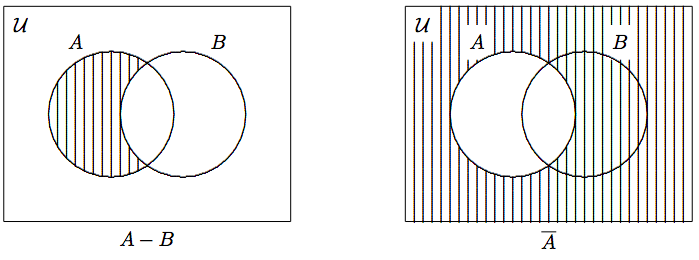4.3: Unions and Intersections
- Page ID
- 8403
We can form a new set from existing sets by carrying out a set operation.
Definition: intersection
Given two sets \(A\) and \(B\), define their intersection to be the set
\[A \cap B = \{ x\in{\cal U} \mid x \in A \wedge x \in B \} \nonumber\]
Loosely speaking, \(A \cap B\) contains elements common to both \(A\) and \(B\).
Definition
The union of \(A\) and \(B\) is defined as
\[A \cup B = \{ x\in{\cal U} \mid x \in A \vee x \in B \} \nonumber\]
Thus \(A \cup B\) is, as the name suggests, the set combining all the elements from \(A\) and \(B\).

Definition
The set difference \(A-B\), sometimes written as \(A \setminus B\), is defined as
\[A- B = \{ x\in{\cal U} \mid x \in A \wedge x \not\in B \} \nonumber\]
In words, \(A-B\) contains elements that can only be found in \(A\) but not in \(B\). Operationally speaking, \(A-B\) is the set obtained from \(A\) by removing the elements that also belong to \(B\). Therefore, the set difference \(A-B\) is also called the relative complement of \(B\) in \(A\). In particular, \({\cal U}-A\) is called the complement of \(A\), and is denoted by \(\overline{A}\), \(A'\) or \(A^c\).

Remark
We would like to remind the readers that it is not uncommon among authors to adopt different notations for the same mathematical concept. Likewise, the same notation could mean something different in another textbook or even another branch of mathematics. It is important to develop the habit of examining the context and making sure that you understand the meaning of the notations when you start reading a mathematical exposition.
Example \(\PageIndex{1}\label{eg:unionint-01}\)
Let \({\cal U}=\{1,2,3,4,5\}\), \(A=\{1,2,3\}\), and \(B=\{3,4\}\). Find \(A\cap B\), \(A\cup B\), \(A-B\), \(B-A\), \(\overline{A}\), and \(\overline{B}\).
- Solution
-
We have \[\begin{array}{r c l} A\cap B &=& \{3\}, \\ A\cup B &=& \{1,2,3,4\}, \\ A - B &=& \{1,2\}, \\ B - A &=& \{4\}. \end{array} \nonumber\] We also find \(\overline{A} = \{4,5\}\), and \(\overline{B} = \{1,2,5\}\).
hands-on exercise \(\PageIndex{1}\label{he:unionint-01}\)
Let \({\cal U} = \{\mbox{John}, \mbox{Mary}, \mbox{Dave}, \mbox{Lucy}, \mbox{Peter}, \mbox{Larry}\}\), \[A = \{\mbox{John}, \mbox{Mary}, \mbox{Dave}\}, \qquad\mbox{and}\qquad B = \{\mbox{John}, \mbox{Larry}, \mbox{Lucy}\}. \nonumber\] Find \(A\cap B\), \(A\cup B\), \(A-B\), \(B-A\), \(\overline{A}\), and \(\overline{B}\).
hands-on exercise \(\PageIndex{2}\label{he:unionint-02}\)
If \(A\subseteq B\), what would be \(A-B\)?
Example \(\PageIndex{2}\label{eg:unionint-02}\)
The set of integers can be written as the \[\mathbb{Z} = \{-1,-2,-3,\ldots\} \cup \{0\} \cup \{1,2,3,\ldots\}. \nonumber\] Can we replace \(\{0\}\) with 0? Explain.
hands-on exercise \(\PageIndex{3}\label{he:unionint-03}\)
Explain why the following expressions are syntactically incorrect.
- \(\mathbb{Z} = \{-1,-2,-3,\ldots\} \cup \;0\; \cup \{1,2,3,\ldots\}\).
- \(\mathbb{Z} = \ldots,-3,-2,-1 \;\cup\; 0 \;\cup\; 1,2,3,\ldots\,\)
- \(\mathbb{Z} = \ldots,-3,-2,-1 \;+\; 0 \;+\; 1,2,3,\ldots\,\)
- \(\mathbb{Z} = \mathbb{Z} ^- \;\cup\; 0 \;\cup\; \mathbb{Z} ^+\)
How would you fix the errors in these expressions?
Example \(\PageIndex{3}\label{eg:unionint-03}\)
For any set \(A\), what are \(A\cap\emptyset\), \(A\cup\emptyset\), \(A-\emptyset\), \(\emptyset-A\) and \(\overline{\overline{A}}\)?
- Answer
-
It is clear that \[A\cap\emptyset = \emptyset, \qquad A\cup\emptyset = A, \qquad\mbox{and}\qquad A-\emptyset = A. \nonumber\] From the definition of set difference, we find \(\emptyset-A = \emptyset\). Finally, \(\overline{\overline{A}} = A\).
Example \(\PageIndex{4}\label{eg:unionint-04}\)
Write, in interval notation, \([5,8)\cup(6,9]\) and \([5,8)\cap(6,9]\).
- Answer
-
The answers are \[[5,8)\cup(6,9] = [5,9], \qquad\mbox{and}\qquad [5,8)\cap(6,9] = (6,8). \nonumber\] They are obtained by comparing the location of the two intervals on the real number line.
hands-on exercise \(\PageIndex{4}\label{he:unionint-04}\)
Write, in interval notation, \((0,3)\cup[-1,2)\) and \((0,3)\cap[-1,2)\).
Example \(\PageIndex{5}\label{eg:unionint-05}\)
We are now able to describe the following set \[\{x\in\mathbb{R} \mid (x<5) \vee (x>7)\} \nonumber\] in the interval notation. It can be written as either \((-\infty,5)\cup(7,\infty)\) or, using complement, \(\mathbb{R}-[5,7\,]\). Consequently, saying \(x\notin[5,7\,]\) is the same as saying \(x\in(-\infty,5) \cup(7,\infty)\), or equivalently, \(x\in \mathbb{R}-[5,7\,]\).
Theorem \(\PageIndex{1}\label{thm:setprop}\)
The following properties hold for any sets \(A\), \(B\), and \(C\) in a universal set \({\cal U}\).
- Commutative properties: \(\begin{array}[t]{l} A \cup B = B \cup A, \\ A \cap B = B \cap A. \end{array}\)
- Associative properties: \(\begin{array}[t]{l} (A \cup B) \cup C = A \cup (B \cup C), \\ (A \cap B) \cap C = A \cap (B \cap C). \end{array}\)
- Distributive laws: \(\begin{array}[t]{l} A \cup (B \cap C) = (A \cup B) \cap (A \cup C), \\ A \cap (B \cup C) = (A \cap B) \cup (A \cap C). \end{array}\)
- Idempotent laws: \(\begin{array}[t]{l} A \cup A = A, \\ A \cap A = A. \end{array}\)
- De Morgan’s laws: \(\begin{array}[t]{l} \overline{A \cup B} = \overline{A} \cap \overline{B}, \\ \overline{A \cap B} = \overline{A} \cup \overline{B}. \end{array}\)
- Laws of the excluded middle, or inverse laws: \(\begin{array}[t]{l} A \cup \overline{A} = {\cal U}, \\ A \cap \overline{A} = \emptyset. \end{array}\)
As an illustration, we shall prove the distributive law \[A \cup (B \cap C) = (A \cup B) \cap (A \cup C). \nonumber\] We need to show that \[\forall x\in{\cal U}\, \big[x \in A \cup (B \cap C) \Leftrightarrow x \in (A \cup B) \cap (A \cup C) \big]. \nonumber\] Equivalently, we need to show that \[A \cup (B \cap C) \subseteq (A \cup B) \cap (A \cup C), \qquad\mbox{and}\qquad (A \cup B) \cap (A \cup C) \subseteq A \cup (B \cap C). \nonumber\] Either way, we need to establish the equality in two steps.
We now present two proofs of the distributive law \(A \cup (B \cap C) = (A \cup B) \cap (A \cup C)\).
- Proof 1
-
Let \(x\in A\cup(B\cap C)\). Then \(x\in A\), or \(x\in B\cap C\). We know that \(x\in B\cap C\) implies that \(x\in B\) and \(x\in C\). So we have
- \(x\in A\) or \(x\in B\), and
- \(x\in A\) or \(x\in C\);
equivalently,
- \(x\in A\cup B\), and
- \(x\in A\cup C\).
Thus, \(x\in (A\cup B)\cap (A\cup C)\). We have proved that \(A\cup(B\cap C) \subseteq (A\cup B)\cap(A\cup C)\).
Now let \(x\in (A\cup B)\cap(A\cup C)\). Then \(x\in A\cup B\) and \(x\in A\cup C\). From the definition of union, we find
- \(x\in A\) or \(x\in B\), and
- \(x\in A\) or \(x\in C\).
Both conditions require \(x\in A\), so we can rewrite them as
- \(x\in A\), or
- \(x\in B\) and \(x\in C\);
equivalently,
- \(x\in A\), or
- \(x\in B\cap C\).
Thus, \(x\in A\cup(B\cap C)\). This proves that \((A\cup B)\cap(A\cup C) \subseteq A\cup(B\cap C)\). Together with \(A\cup(B\cap C) \subseteq (A\cup B)\cap(A\cup C)\), we conclude that \(A\cup(B\cap C) = (A\cup B) \cap(A\cup C)\).
Below is an alternate proof. This type of argument is shorter, but is more symbolic; hence, it is more difficult to follow.
- Proof 2
-
Since \[ \begin{array}{r l l} x \in A \cup (B \cap C) & \Leftrightarrow x \in A \vee x \in (B \cap C) & (\text{defn. of union}) \\ & \Leftrightarrow x \in A \vee (x \in B \wedge x \in C) & (\text{defn. of intersection}) \\ & \Leftrightarrow (x \in A \vee x \in B) \wedge (x \in A \vee x \in C) & (\text{distributive law}) \\ & \Leftrightarrow (x \in A \cup B) \wedge (x \in A \cup C) & (\text{defn. of union}) \\ & \Leftrightarrow x \in (A \cup B) \cap (A \cup B) & (\text{defn. of intersection}) \end{array} \nonumber\] it follows that \(A \cup (B \cap C) = (A\cup B) \cap (A\cup C)\).
hands-on exercise \(\PageIndex{5}\label{he:unionint-05}\)
Prove that \(A\cap(B\cup C) = (A\cap B)\cup(A\cap C)\).
hands-on exercise \(\PageIndex{6}\label{he:unionint-06}\)
Prove that if \(A\subseteq B\) and \(A\subseteq C\), then \(A\subseteq B\cap C\).
- Discussion
-
Let us start with a draft. The statement we want to prove takes the form of \[(A\subseteq B) \wedge (A\subseteq C) \Rightarrow A\subseteq B\cap C. \nonumber\] Hence, what do we assume and what do we want to prove?
Assume: Want to Prove: Did you put down we assume \(A\subseteq B\) and \(A\subseteq C\), and we want to prove \(A\subseteq B\cap C\)? Great! Now, what does it mean by \(A\subseteq B\)? How about \(A\subseteq C\)? What is the meaning of \(A\subseteq B\cap C\)?
\(A\subseteq B\) means: For any \(x\in{\cal U}\), if \(x\in A\), then \(x\in B\) as well. \(A\subseteq C\) means: \(A\subseteq B\cap C\) means: How can you use the first two pieces of information to obtain what we need to establish?
Now it is time to put everything together, and polish it into a final version. Remember three things:
- the outline of the proof,
- the reason in each step of the main argument, and
- the introduction and the conclusion.
Put the complete proof in the space below.
Here are two results involving complements.
Theorem \(\PageIndex{1}\label{thm:subsetsbar}\)
For any two sets \(A\) and \(B\), we have \(A \subseteq B \Leftrightarrow \overline{B} \subseteq \overline{A}\).
Theorem \(\PageIndex{1}\label{thm:genDeMor}\)
For any sets \(A\), \(B\) and \(C\), \[\begin{aligned} A-(B\cup C) &=& (A-B)\cap(A-C), \\ A-(B\cap C) &=& (A-B)\cup(A-C), \end{aligned} \nonumber\]
Summary and Review
- Memorize the definitions of intersection, union, and set difference. We rely on them to prove or derive new results.
- The intersection of two sets \(A\) and \(B\), denoted \(A\cap B\), is the set of elements common to both \(A\) and \(B\). In symbols, \(\forall x\in{\cal U}\,\big[x\in A\cap B \Leftrightarrow (x\in A \wedge x\in B)\big]\).
- The union of two sets \(A\) and \(B\), denoted \(A\cup B\), is the set that combines all the elements in \(A\) and \(B\). In symbols, \(\forall x\in{\cal U}\,\big[x\in A\cap B \Leftrightarrow (x\in A\vee x\in B)\big]\).
- The set difference between two sets \(A\) and \(B\), denoted by \(A-B\), is the set of elements that can only be found in \(A\) but not in \(B\). In symbol, it means \(\forall x\in{\cal U}\, \big[x\in A-B \Leftrightarrow (x\in A \wedge x\notin B)\big]\).
- Know the properties of intersection, union, and set differences listed in Theorem 4.3.1.
Exercise \(\PageIndex{1}\label{ex:unionint-01}\)
Write each of the following sets by listing its elements explicitly.
- \([-4,4]\cap\mathbb{Z}\)
- \((-4,4]\cap\mathbb{Z}\)
- \((-4,\infty)\cap\mathbb{Z}\)
- \((-\infty,4]\cap\mathbb{N}\)
- \((-4,\infty)\cap\mathbb{Z}^-\)
- \((4,5)\cap\mathbb{Z}\)
Exercise \(\PageIndex{2}\label{ex:unionint-02}\)
Assume \({\cal U} = \mathbb{Z}\), and let
\[ \begin{array}{c} A=\{\ldots, -6,-4,-2,0,2,4,6, \ldots \} = 2\mathbb{Z}, \\ B=\{\ldots, -9,-6,-3,0,3,6,9, \ldots \} = 3\mathbb{Z}, \\ C=\{\ldots, -12,-8,-4,0,4,8,12, \ldots \} = 4\mathbb{Z}. \end{array} \nonumber\]
Describe the following sets by listing their elements explicitly.
- \(A\cap B\)
- \(C-A\)
- \(A-B\)
- \(A\cap\overline{B}\)
- \(B-A\)
- \(B\cup C\)
- \((A\cup B)\cap C\)
- \((A\cup B)-C\)
Exercise \(\PageIndex{3}\label{ex:unionint-03}\)
Are these statements true or false?
- \([1,2]\cap[2,3] = \emptyset\)
- \([1,2)\cup(2,3] = [2,3]\)
Exercise \(\PageIndex{4}\label{ex:unionint-04}\)
Let the universal set \({\cal U}\) be the set of people who voted in the 2012 U.S. presidential election. Define the subsets \(D\), \(B\), and \(W\) of \({\cal U}\) as follows: \[\begin{array}{r c l} D &=& \{x\in{\cal U} \mid x \mbox{ registered as a Democrat}\}, \\ B &=& \{x\in{\cal U} \mid x \mbox{ voted for Barack Obama}\}, \\ W &=& \{x\in{\cal U} \mid x \mbox{ belonged to a union}\}. \end{array} \nonumber\] Express the following subsets of \({\cal U}\) in terms of \(D\), \(B\), and \(W\).
- People who did not vote for Barack Obama.
- Union members who voted for Barack Obama.
- Registered Democrats who voted for Barack Obama but did not belong to a union.
- Union members who either were not registered as Democrats or voted for Barack Obama.
- People who voted for Barack Obama but were not registered as Democrats and were not union members.
- People who were either registered as Democrats and were union members, or did not vote for Barack Obama.
Exercise \(\PageIndex{5}\label{ex:unionint-05}\)
An insurance company classifies its set \({\cal U}\) of policy holders by the following sets: \[\begin{array}{r c l} A &=& \{x\mid x\mbox{ drives a subcompact car}\}, \\ B &=& \{x\mid x\mbox{ drives a car older than 5 years}\}, \\ C &=& \{x\mid x\mbox{ is married}\}, \\ D &=& \{x\mid x\mbox{ is over 21 years old}\}, \\ E &=& \{x\mid x\mbox{ is a male}\}. \end{array} \nonumber\] Describe each of the following subsets of \({\cal U}\) in terms of \(A\), \(B\), \(C\), \(D\), and \(E\).
- Male policy holders over 21 years old.
- Policy holders who are either female or drive cars more than 5 years old.
- Female policy holders over 21 years old who drive subcompact cars.
- Male policy holders who are either married or over 21 years old and do not drive subcompact cars.
Exercise \(\PageIndex{6}\label{ex:unionint-06}\)
Let \(A\) and \(B\) be arbitrary sets. Complete the following statements.
- \(A\subseteq B \Leftrightarrow A\cap B = ~ \rule{3cm}{0.4pt}\).
- \(A\subseteq B \Leftrightarrow A\cup B = ~ \rule{3cm}{0.4pt}\).
- \(A\subseteq B \Leftrightarrow A - B = ~ \rule{3cm}{0.4pt}\).
- \(A\subset B \Leftrightarrow (A-B=~ \rule{3cm}{0.4pt}\,\wedge\,B-A\neq~ \rule{3cm}{0.4pt}\,)\).
- \(A\subset B \Leftrightarrow (A\cap B=~ \rule{3cm}{0.4pt}\,\wedge\,A\cap B\neq~ \rule{3cm}{0.4pt}\,)\).
- \(A - B = B - A \Leftrightarrow ~ \rule{3cm}{0.4pt}\,\).
Exercise \(\PageIndex{7}\label{ex:unionint-07}\)
Give examples of sets \(A\) and \(B\) such that \(A\in B\) and \(A\subset B\).
Exercise \(\PageIndex{8}\label{ex:unionint-08}\)
Prove the De Morgan’s laws.
Exercise \(\PageIndex{9}\label{ex:unionint-09}\)
Let \(A\), \(B\), and \(C\) be any three sets. Prove that if \(A\subseteq C\) and \(B\subseteq C\), then \(A\cup B\subseteq C\).
Exercise \(\PageIndex{10}\label{ex:unionint-10}\)
Prove Theorem 4.3.2
Exercise \(\PageIndex{11}\label{ex:unionint-11}\)
Prove Theorem 4.3.3
Exercise \(\PageIndex{12}\label{ex:unionint-12}\)
Let \(A\), \(B\), and \(C\) be any three sets. Prove that
- \(A-B=A\cap\overline{B}\)
- \(A=(A-B)\cup(A\cap B)\)
- \(A-(B-C) = A\cap(\overline{B}\cup C)\)
- \((A-B)-C = A-(B\cup C)\)
Exercise \(\PageIndex{13}\label{ex:unionint-13}\)
Comment on the following statements. Are they syntactically correct?
- \(x\in A \cap x\in B \equiv x\in A\cap B\)
- \(x\in A\wedge B \Rightarrow x\in A\cap B\)
Exercise \(\PageIndex{14}\label{ex:unionint-14}\)
Prove or disprove each of the following statements about arbitrary sets \(A\) and \(B\). If you think a statement is true, prove it; if you think it is false, provide a counterexample.
- \(\wp(A\cap B) = \wp(A)\cap\wp(B)\)
- \(\wp(A\cup B) = \wp(A)\cup\wp(B)\)
- \(\wp(A - B) = \wp(A) - \wp(B)\)
- Remark
-
To show that two sets \(U\) and \(V\) are equal, we usually want to prove that \(x\in U \Leftrightarrow x\in V\). In this problem, the element \(x\) is actually a set. Since we usually use uppercase letters to denote sets, we should start the proof of (a) with “Let \(S\in\wp(A\cap B)\).” If you prefer to use the alternate approach, it looks like the following: \[\begin{array}{r c l} S\in\wp(A\cap B) &\Leftrightarrow& \ldots \\ &\Leftrightarrow& \ldots \\ &\vdots& \\ &\Leftrightarrow& S\in\wp(A)\cap\wp(B). \end{array} \nonumber\] These remarks also apply to (b) and (c).


